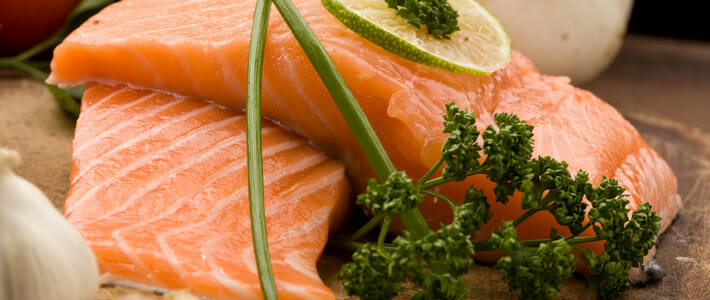Salmon, Pacific

Pacific salmon are a saltwater fish that spawn in fresh water. The Columbia River, Puget Sound country, and, of course, Alaska are especially noted for their fine salmon.
There are five species of Pacific Salmon, Chinook or King (average in size 10-15 lbs. up to 135 lbs.), Sockeye or Red (average 5-8 lbs up to 15 lbs.), Coho or Silver (average 6-12 lbs up to 31 lbs.), Chum or Dog (average 10-15 up to 33 lbs.), and Pink or Humpback (average 3-5 lbs. up to 12 lbs.).
Product pdf for download-
4 oz (114g) raw edible portion
-
Calories 140
-
Total Fat 4.5g
-
Saturated Fat 1g
-
Cholesterol 85mg
-
Sodium 55mg
-
Carbohydrates 0g
-
Protein 23g
Life Cycle
Spawned in freshwater streams, the young salmon travel to sea early. Here they live and grow for three or four years. In the spring after they reach maturity, the adult salmon return to their native streams to spawn. As salmon begin their journey home, they will stop eating and live mainly on the oils stored in their bodies. In some mysterious way, they orient themselves and swim homeward with precision equaling electronically equipped ocean sailors. The distances they travel and their astounding return to the exact point on earth where they emerged from their egg sacs is amazing.
Interesting Fact
For some unknown reason, the female always dies after spawning.
Alternatives
Altantic Salmon.
Source
Chinook salmon is known to range as far north as the Mackenzie River and Kugluktuk in the central Canadian arctic.
Chum salmon has the widest geographic range of the Pacific species: south to the Sacramento River in California in the eastern Pacific and the island of Kysh in the Sea of Japan in the western Pacific; north to the Mackenzie River in Canada in the east and to the Lena River in Siberia in the west.
Coho salmon is found throughout the coastal waters of Alaska and British Columbia and up most clear-running streams and rivers.
Pink salmon is found from northern California and Korea, throughout the northern Pacific, and from the Mackenzie River in Canada to the Lena River in Siberia, usually in shorter coastal streams.
Sockeye salmon is found south as far as the Klamath River in California in the eastern Pacific and northern Hokkaid? Island in Japan in the western Pacific and as far north as Bathurst Inlet in the Canadian Arctic in the east and the Anadyr River in Siberia in the west.
Harvest Method
There are three common techniques for commercial fishing – seining, gill netting, and trolling.
Appearance
To cooks, gourmets, and fishermen alike, the salmon is the king of the waters. The distinctive color of the flesh of a salmon is part of its attraction. It can vary from a very delicate pale pink to a much deeper shade, verging on red.
Flavor
Chinook salmon, also known as King salmon, are considered by many to be the best-tasting salmon. They have a very high fat content and corresponding rich flesh that ranges from white to a deep red color.
Chum is also called dog salmon for its dog-like teeth. It’s a smaller fish with pale to medium-colored flesh and a lower fat content than other salmon. Chum is usually canned or sold frozen to foreign markets.
Coho salmon are sometimes called silver salmon or “silvers” because of their especially silver skin. They have bright red flesh and a slightly more delicate texture than King salmon but a similar flavor.
Pink salmon are the most common Pacific salmon. They have very light colored (and flavored) flesh and a low fat content. Pink salmon are often canned, but also sold fresh, frozen, and smoked. They are sometimes called “humpies” because of the distinctive hump they develop on their back when they spawn.
Sockeye are noted for their bright red-orange flesh and deep rich flavor. They are known as “reds” both for their dark flesh color and because they turn deep red (from a bright silver) as they move upstream to spawn.
Texture
Firm texture.
Preparation
The one cardinal rule is: NEVER OVERCOOK SALMON. Although it is an oily fish, overcooking makes the flesh dry and dense, and it can become quite chewy in texture.
Quality Control
Salmon is one of the safest fish for consumption on the market, combining great nutrition and taste with a high degree of food safety.
Market Segments
This fish is appropriate for casual dining, fine dining, hotels, and resort/club markets./p>